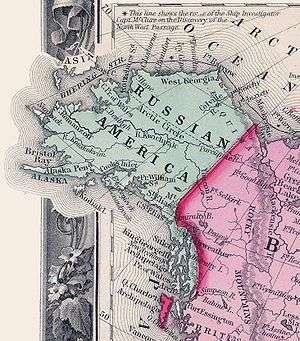Treaty of Saint Petersburg (1825)

The Treaty of Saint Petersburg of 1825 or the Anglo-Russian Convention of 1825, officially the Convention Concerning the Limits of Their Respective Possessions on the Northwest Coast of America and the Navigation of the Pacific Ocean,[1] defined the boundaries between Russian America and British claims and possessions in the Pacific Northwest of North America at parallel 54°40′ north, which had the year before been established as the limit of overlapping American claims in the parallel Russo-American Treaty of 1824. The Russian sphere in the region was later sold to the United States, becoming Alaska, while to the south of the division point was the British claim, the remnant of which today is coast of the Canadian province of British Columbia.[2][3] and associated rights and obligations concerning waters and ports in the region. The treaty, in establishing a vague division of coastal Russian interests and inland British interests northward from 56 degrees north, led to conflicting interpretations of the meaning of the treaty's wording which later manifested in the Alaska Boundary Dispute between the United States on the one hand, and Canada and the British Empire on the other.
Other terms of the treaty, including the right to navigation by British vessels to both commerce in the region affected, and also access to rivers crossing the designated boundary, were exercised by the Hudson's Bay Company in 1834 but were met with opposition by then Russian-American Company Governor Wrangel in the form of warships and a blockade. This conflict, known as the Dryad affair,[4] led to the RAC-HBC Agreement, in which the RAC agreed to lease the mainland portion of the region south of Cape Spencer at the entrance to Cross Sound and the HBC promised to supply Russian America with foodstuffs and manufactured goods. In addition the HBC waived its demand for payments for damages incurred during the Dryad affair.[5] The same clauses enabled British access to the Stikine River goldfields in 1862 but were not assumed by the Americans upon their purchase of Russian interests in 1867, resulting in further conflict over British rights of access to the inland regions. The treaty's terms also played a part in the terms of the Bering Sea Arbitration and likewise in terms of other decisions in Alaska and US courts over marine and offshore interests.
See also
References
- ↑ International Environmental Law Reports, Vol. 1. ed. A. R. Robb. Cambridge, UK: Cambridge University Press. 1999, p. 560.
- ↑ A Merged History of Canada and The United States, Bill Jones, ExploreNorth.com website, see section "1825: Anglo-Russian Convention"
- ↑ Chronology of Alaska and Yukon history
- ↑ J. W. Shelest, The Dryad Affair: Corporate Warfare and Anglo-Russian Rivalry for the Alaskan Lisière, 1989.
- ↑ The Hudson's Bay Company, page 154
External links
- Convention Between Great Britain and Russia, 1825 (Treaty of St. Petersburg)